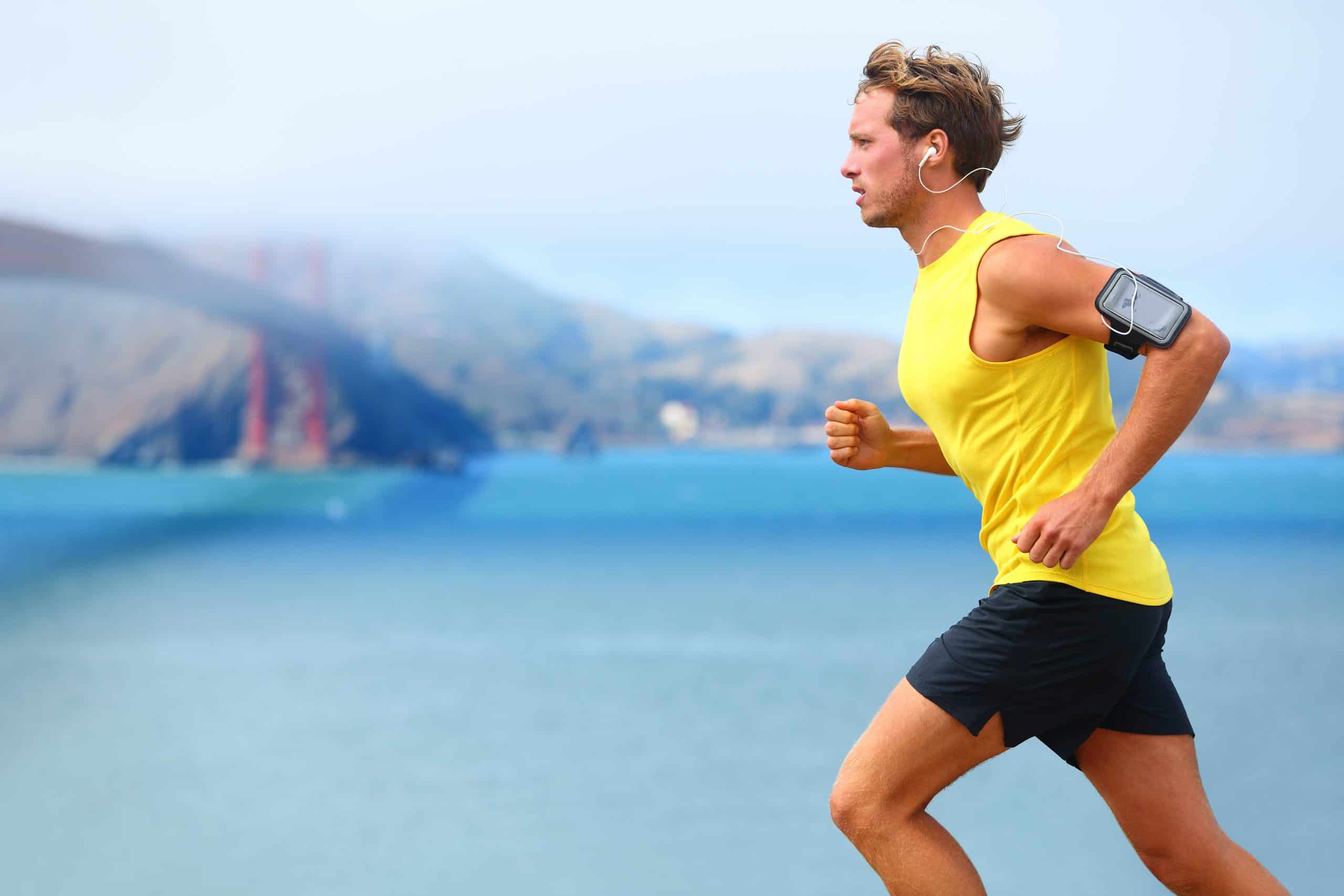Your heart is beating rapidly, sweat is running down your back, and your leg muscles feel like they’re on fire. You stop for a second, but the fire in your muscles persists, and your breathing seems to get even more rapid. Sounds familiar, doesn’t it?
Running can do a lot of things to your body, but it doesn’t stop at quick heartbeats and rapid breath. There are changes that you see and feel, and there are changes that you probably don’t know about.
So, what does running do for your body? Here are the benefits and side effects you can encounter.

8 Good Things Running Does for Your Body
Let’s start with the good things running does for your body. Running is known to help with weight loss, improve your heart health, and get your muscles moving. But what else?
1. Moves All of Your Muscles
Although people usually perceive running as a lower-body exercise, it’s one of the best full-body exercises you can adopt. Running burns fat and moves all of your muscle groups, including the obliques, quads, glutes, rectus abdominis, and hamstrings.
Of course, it depends on how fast you run. Sprinting works your core muscles the best, and running up a slope will stress your glutes and calves in a healthy way.
Generally, running is an excellent exercise if you want to work all your body muscles.
2. Gives You Better Sleep
Try sitting around doing nothing all day, and you’ll see the negative effects at night when you’re rolling in your bed, unable to sleep. Exercise does quite the opposite.
Moving all of your body muscles doesn’t only help tone your body and keep you in shape. It also gives you a night of better sleep because you’ll naturally feel drowsy after an intense exercise.
On top of that, running outdoors gives you some fresh air that may help you sleep at night.
A study was actually carried out to explore the results of this, and as it turns out, adopting a regular running schedule can give you better sleep.
3. Builds Your Endurance
Do you know how physical activity and aerobic exercise are used to build endurance or improve stamina? Running can deliver the same purpose.
Stamina, or endurance, is your body’s ability to handle physical activity for a long time. If you manage to build it, you’ll be able to sustain intense exercises like they’re nothing, and your body will get in shape faster than you expect.
Running builds endurance because it puts stress on your muscles and vascular system, and it pushes your lungs over their comfort zone.
4. Boosts Your Calorie-Burning Rate
Like any intense workout, running can turn your body into a calorie-burning machine. If you’re trying to shed some extra belly fat, running can be the easiest way to get rid of the body fat.
I’m not saying running is easy, but it’s easier on your body to handle than burpees, lunges, and HIIT workouts. And, it can get you the same results if you persist.
Some people can burn up to 700 calories after running for an hour. Of course, it varies according to your weight, but it’s still impressive. Your body also keeps burning fat for some time after you stop running.
5. Protects You From Cardiovascular Diseases
Aside from getting lean muscle, the most popular benefit of running is protecting your body against heart disease.
When you run, your muscles get worked up and start needing blood. Your lungs and heart then work in harmony to deliver. The more you run, the more you work both organs, thereby keeping them active and preventing cardiovascular diseases.
It kind of works in the same way as your muscles. When you push your muscles, they perform better and grow stronger. The same goes for your heart and lungs.
A 15-year study was carried out to explore this claim, and it turns out people who run regularly have a 30%-45% lower risk of dying because of cardiovascular disease.
6. Protects You From Degenerative Diseases
As you probably know, most degenerative diseases have no definite cure. The medications are only used to relieve symptoms and increase life expectancy. But when the neurons start dying, the condition becomes harder.
Infusing running or jogging into your daily schedule can protect you from degenerative diseases and cognitive decline in general. That’s because regular exercise improves your focus and memory, especially for seniors.
7. Strengthens Your Bones
Any weight-bearing exercise can do wonders for your bone density, running included. When you move your legs in rhythmic harmony, your bones start changing to adapt to the impact being forced on them, growing stronger over time.
Don’t forget that your bones are, in the end, tissues. They respond and change according to the stress they’re under, no differently from muscles.
So, regularly running can significantly strengthen your bones for other exercises and improve your body composition. It’ll also give your bones an overall better shape and prevent aging conditions like rough knees.

8. Puts You in a Better Shape
If your muscles get pulled, and your knee starts hurting after any mild physical activity, you probably need some exercise to strengthen your bones. When you run regularly, your muscles grow stronger, and your bones become healthier. Eventually, you’ll stop feeling pain when you climb the stairs or walk a long track.
By ‘putting you in good shape,’ I don’t mean burning calories. What I mean is, your body will be healthier overall, and your muscles will be in good shape. Your posture may also need some improvement if you work on a desk for long hours.
Bear in mind that running may worsen knee pain if you’re doing it wrong or if you’re overweight. Make sure to monitor your weight and how long you should run to avoid hurting your knees.
5 Side Effects Running May Leave on Your Body
Although running is fun and packed with benefits, there are still some negative effects associated with it, such as injury and dehydration.
You likely won’t see these effects if you run at a healthy rate and don’t overdo it. However, if you’re pushing your body too far and you’re not lifting weights to balance the exercise, you’re in for some side effects.
1. Runner’s Knee
Among all running injuries, the runner’s knee is the most common.
Runner’s knee is a casual term that’s used to describe an array of knee conditions, mostly results of overuse injuries. They’re all associated with physical activity, hence the name. On top of that, they’re most common among athletes.
If you overdo running, you’re putting too much stress on your cartilage and knee caps. As a result, you become prone to patellofemoral pain syndrome, which is basically irritation between your femur and kneecap. You may feel the pain when climbing stairs, but some people feel it when sitting doing nothing.
One way to avoid a runner’s knee is to ease yourself into the exercise. Don’t speed up at once, and try not to increase your running by a high rate every day. Start easy, and only increase your speed when you’re ready. Additionally, warm-ups are essential to keep your bones healthy.
If you’re already feeling pain, you may want to consult a doctor to tell you whether you need treatment.
2. Muscle Imbalance
If you only run without doing any other workout, you may be prone to muscle imbalance. Muscle imbalance happens when some muscle groups are stronger or larger than their counterparts.
All runners are at risk of this if they don’t do any strength training. And, of course, this imbalance raises the chance of running injuries later on.
Improving your muscle mass is as easy as incorporating some weight training in your weekly workout plan. That way, you’ll work on your upper muscles, so they aren’t neglected. You can also start working on your leg muscles with workouts like squats or lunges. This could help align your hips better with your knees while running.
3. Skin Irritation
Skin irritation doesn’t really seem like a running injury, right?
Well, it’s not an injury per se, but it’s definitely a side effect of running. If you tend to run for hours, you can start feeling skin irritation in various areas of your body. For women, it’s common to feel irritation near the bikini line, underarms, or between thighs. Meanwhile, men can feel it in the groin area or their chests.
More often than not, the irritation is a result of clothes chafing against the skin or sweating. Or, if you’re not wearing the proper attire, your skin may be rubbing against itself, which will inevitably cause some redness and mild pain.
Some runners also suffer irritation for none of the previously-mentioned reasons. Instead, they simply have dry skin that develops itching when they run.
To prevent skin irritation, you can make sure to wear clothes that keep your skin off each other, especially near the thighs and under the arms. As a last resort, you can wrap some bandages around areas that cause the most pain.
4. Dehydration and Dizziness
I know the temptation to stop suddenly after an intense run is strong, but avoid doing it. When you run for a long time and stop suddenly, you’ll feel a rush of dizziness, and your blood pressure may drop. Some people will even have a couple of seconds of compromised vision.
To prevent those side effects, stop running gradually to get your heart rate back to normal.
One more thing you may need to resist doing is chugging a full bottle of water after you’re done running.
For one, it’s not good for rehydration. Plus, if the water is cold, you may shock your digestive system and cause stomach pain. What you should do is sip water naturally and give your body time to recover. Sipping amidst running will also reduce the risk of dehydration.
You don’t want to get dehydration during running because it’ll cause a dry, sore throat. In addition to that, you may get a feeling that you want to urinate when that’s not the case. That’s because your body is trying to hold onto the amount of urine it has. It’s easier to drink enough water before the workout.
5. Black Toenails
No, I don’t mean black toenails as in black, manicured toenails. Sometimes, you’ll bleed when you run in bad trainers, and the blood will get stuck between your skin and nail, causing a black or a deep red color to appear. More often than not, it’s just a small batch that eventually goes away, but it doesn’t look appealing.
To prevent black toenails, make sure to wear a pair of trainers your size. If they’re too small or tight, you can say goodbye to the natural skin color your nails have. You can also regularly cut your nails because they’ll hit against your shoes more if they get tall.
Tips for Having a Healthy Running Exercise
If you want to maintain your fitness but don’t want to spend the upcoming months recovering from a running injury, following these tips may help.
- Buy the right shoes: When choosing your running shoes, make sure to visit a specialty store, so experts will help you pick them. And, remember to replace the pair after every 500 miles or so.
- Take time to rest: Rushing your muscles into exercise won’t do you any good. Make sure to have sufficient recovery time between exercises, and don’t overstress your muscles.
- Try strength training: Running is good, but it’s not enough if you’re aiming for physical fitness. Try to include some weight lifting exercises in your weekly routine.
- Work on your running cadence: Pounding your heels on the ground while running will only increase your risk of injury. Monitoring the number of steps you take in one minute will help you realize if you’re doing it wrong. As a rule of thumb, the higher the number of steps, the less pounding you are doing.
- Drink enough water: Going on a running exercise without drinking enough water is an open invitation for dehydration. Make sure to drink enough water throughout the day and only sip small amounts right after you’re done with the exercise.

To Wrap Up, What Does Running do for Your Body?
Most of the time, running is highly beneficial for your body and muscles. However, it may become a double-edged sword if you exercise incorrectly, wear uncomfortable trainers, or don’t drink enough water.
Most running injuries are persistent and need time to heal. Try to avoid them from the start by running at a healthy rate and avoiding overstressing your muscles.

